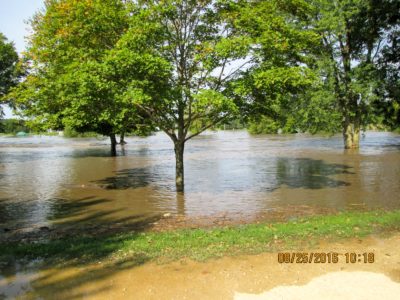
By Calvin Tang
tamgcalv@grinnell.edu
Thunderstorms and heavy rain have plagued Iowa and the Midwest for the last few days, with the water levels seen to cover houses and even short buildings. Decorah, Bluffton, Fort Atkinson and Spillville all reported heavy rainfall, and the Turkey River approached a record crest. Residents of northeastern Iowa found it hard to sleep through road closures and forced evacuations. Although water supplies and water treatment plants sustained light damage, some systems may develop complications later on.
The flooding has recently claimed one victim as of last week, as mentioned in The Courier. The victim was a driver and managed to dial 911. While authorities were able to find the car, the body wasn’t found until it was too late.
Multiple agencies have been called into action to help with the relief efforts and to provide aid to those who are in need.
The Department of Natural Resources (DNR) is among the responders and is continuing to provide aid.
“[We] first got called that systems were impacted on Aug. 24,” said Amber Sauser, an environmental specialist for the DNR. “The following counties were issued disaster proclamation by the governor: Bremer, Chickasaw, Allamakee, Clayton, Fayette, Howard and Winneshiek,” Sauser wrote in a follow up email to The S&B. Fayette County was one of the more seriously damaged.
In spite of the damages caused to housing and businesses, waste water and water supply systems were also effected by the flooding. Three waste water treatment plants (WWTP) situated in Elma, Alta Vista and Fort Atkinson are reported to have been inundated with water. Fortunately, these damages were mostly short term, and repairs will be made in a timely fashion. However, the costs for repairs were considered quite heavy.
“At this moment, the water and waste water systems, and primarily the waste water systems, [have suffered] predominantly short term damage,” Sauser said.
Most of the systems appear to be back online with only a couple requiring partial disinfection. WWTPs in Spillville and Protivin were unaffected by the flood, and the treatment plants are up and running.
Other systems and storage such as the ultra violet (UV) disinfection system and aerated lagoons in Waucoma and Spillville were impacted, although the extent of the damages may not be clear until weeks or months later.
“Some of them had damage to the UV disinfection system, and often times, they don’t know immediately how long the systems are going to last … two weeks from now or a month from now it could go out and then at that point they may need to replace it, so some of them may still have what could be long term damage,” Sauser said.
Despite the partial disinfection in only one channel, most of these systems normally run with one channel, and therefore, most of UV disinfection systems remain operational.
Many of the cities that were hit were all too familiar with the circumstances, as they were affected by flooding in 2008. Fortunately, no underground storage tanks or animal feeding systems were impacted, and so the damage is certainly mitigated, Sauser explained. The DNR will continue to provide support to face any upcoming issues, and the Parks and Recreations Department will continue to facilitate recovery for their infrastructure. Looking ahead, the DNR will most likely participate in the clean up operation as well, helping to dispose of any waste, such as sandbags, that may have been deployed during the flood.




























































